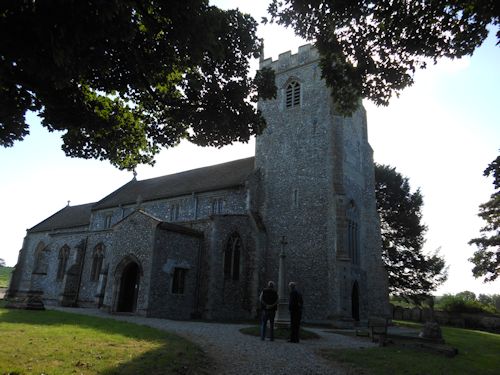Following Nelsonís Footsteps Part 1
"England expects every Man will do his Duty."

Vice-Admiral Horatio Nelson, 1st Viscount Nelson
Trafalgar Square is, without doubt, Londonís most famous square. It is also one of the most instantly recognisable places in the world. It has seen rallies, demonstrations, riots, celebrations and more recently the place where thousands gathered to find out if Paris or London was to be chosen to host the 2012 Olympic Games. The statue perched 170 feet (52 m) above the London skyline, standing higher than any of the kings and queens of England, hand on the sword and looking across to Admiralty Arch, down The Mall to where Nelsonís fleet can be seen above the lamp-posts. Nelsonís column attracts thousands each and every day of the year, yet the statue on top is a commoner whose birthplace is hidden in one of the remotest parts of the English countryside, with very few signposts (I only found one, eventually, opposite his birthplace) a far cry from the congested square where his effigy stands. Driving along deserted country lanes, without a soul anywhere to ask for directions, remarkably I did eventually find it, with its modest plaque inset into a brick wall, confirming to me that this was indeed the birthplace of Britainís most famous and heroic Lord, Horatio Nelson.
Burnham Thorpe - Nelson's Birthplace
The parsonage belonging to All Saints' Church stood on the outskirts of the remote village of Burnham Thorpe in Norfolk. Horatio Nelson was born there on the 29th of September 1758, the fifth son of the rector Edmund Nelson and his wife Catherine (nťe Suckling). No one could have predicted this rather sickly-looking child would one day become Englandís greatest naval hero, and that the name of Horatio Nelson would be known and revered by the English people throughout the centuries to come. Horatioís name came from his mother's side of the family. Catherineís grandmother was the sister of Sir Robert Walpole, politician and the first British Prime Minister during the reigns of George I and George II. The name Horatio first enters the family in 1678 with Horatio Walpole, Robert's brother. The second bearer of the name in the Walpole family, Robert's son, preferred to sign himself Horace.

Site of Nelson's Birthplace
The Nelson family had been settled in Norfolk for generations, yet none had been as noteworthy as those from Catherineís side of the family. One of Nelsonís great-grandfathers had been a baker in Norwich, with both grandfathers being clergymen. Nelsonís birthplace was sadly pulled down three years before his death, but records show the parsonage was a two-storied, L-shaped building, composed of a couple of small houses, or bigger cottages, of different dates and sizes. Looking across the road to the field opposite from where the house once stood, I could see very little could have changed in over two-hundred and fifty years. To me, it seemed very strange that this man whose statue commands one of the most congested sites in London could have spent several years of his early life in this bleak and lonely spot.
I searched the area for his father's church, where both of Nelsonís parents are buried and discovered there were, in fact, two churches, both with the same name of All Saints. The first church I had already passed at Burnham Market so I returned back there first of all. The good thing about this part of East Anglia is that the churches, although the doors are closed, have a latch which anyone can open to enter. I must admit it was very eerie walking into an empty church, my footsteps echoed along the paved floor as I looked at the altar with the brass crucifix, the pulpit, the pews and the organ. At the other end the font and ropes were hanging down from the bell tower, but nowhere could I find the graves of Nelsonís parents. I did, however, discover a list of previous vicars of this church: Edmund Nelson 1755, Suckling Nelson (another of Edmundís sons) 1797, and again Edmund Nelson in 1799.

After looking up the phone number and speaking to the church warden I discovered there was another All Saints at Burnham Thorpe.

Once I located the other All Saints' Church, I again entered another unattended church, which was much larger than the first. Sure enough, by the altar were the graves of both parents of Lord Nelson.
On the opposite end of the church was the font, the very same one where Nelson was christened by his own father. I also found documentation of christenings, with the ten and a half-year-old Horatio Nelsonís signature as a witness.


The idyllic childhood of Nelson came to an abrupt end on Boxing Day 1767, when his mother Catherine died and family life changed thereafter. The rector employed village neighbours to manage his household. The children were sent away to school, Horatio and his elder brother William to Norwich and then later to North Walsham.
Returning back to school a year later after the Christmas holidays, Horatio showed the first signs of his resolution to duty, when snow drifts blocked the roads to Burnham Market, where the boys were to board the coach. William wanted to turn back but Horatio urged him on saying that they had promised their father to make the journey and it was their duty to do so despite the weather.

Graves of Nelson's Father and Mother, Edmond and Catherine
London Time

Follow Us
The contents of this website are the property of knowledgeoflondon.com and therefore must not be reproduced without permission. Every effort is made to ensure the details contained on this website are correct, however, we cannot accept responsibility for errors and omissions.
© Copyright 2004 -
Contact Us | Advertise